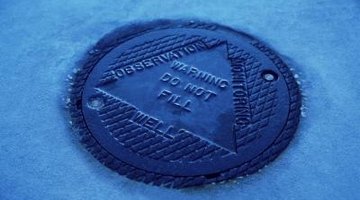How to Lower a Water Table
In some areas of the country, groundwater lies at a shallow depth, affecting the ability of residents to construct homes and gardens. Water tables in coastal zones and inland areas near water bodies typically lie only a few feet below the land surface. The water table generally mimics topography and intersects the land surface where you have surface water. Lowering the water table may be necessary in order to accommodate construction. You can use a water well to lower the groundwater table elevation by pumping water from the ground.

-
Install a groundwater well or use an existing well on your property for the project. You can hire a certified drilling company in your area or install one yourself if the water is at a shallow depth and your state allows property owners to install personal wells.
-
Place a submersible pump in the groundwater well. Follow the manufacturer's instructions for the installation to ensure the pump operates properly. The diameter of the pump must be a smaller than that of your water well.
-
Measure the depth to groundwater in the well before you turn on the pump. To measure the water level, turn on the water level indicator and slowly lower the probe into the well. When the probe intersects the top of the water, you will hear a beep or buzz. Read the depth to water off the graduated tape. Record the water level in a notebook with the date and time and note a zero pumping rate for the measurement.
-
Turn the pump on and estimate a stable pumping rate that the aquifer can sustain. Sandy aquifers will likely tolerate a higher pumping rate than a clay aquifer. You can begin with a slow pumping rate, such as 2 gallons per minute, and increase the rate over time. Average households use a pumping rate of 5 or 6 gallons per minute. As the pump operates, the groundwater will form a cone of depression around the well, lowering the water table. The cone will increase is size until the pumping rate reaches equilibrium. If you stop pumping, the water table will return to its original level.
-
Monitor the water level every four to eight hours when you begin pumping. You can increase the monitoring interval over time. The depth to groundwater in the well should increase, which indicates that the water table is lowering, or becoming deeper underground. Record all of the water level measurements to document the drawdown at different pumping rates.
References
Tips
- If you do not own a water level meter, you can rent one from an environmental equipment supply company.
- You can use a permanent air line to measure the water table elevation if you do not wish to measure the groundwater manually. Install the air line at the same time you install the pump.
Warnings
- The groundwater elevation naturally fluctuates between seasons and weather events. Monitor the water level on a weekly basis after you establish a pumping rate to determine if the flow is adequate.
- Lowering the water table will produce a significant volume of water. You must either store it or dispose of it.
- Do not pump wells that contain contaminated groundwater without consulting the state environmental department.
- Take care to avoid drawing down the water table of adjoining properties.
Writer Bio
Tracy Barnhart is an earth science expert. A professional geologist with over 16 years of technical writing experience, she has expanded her writing skills to include instructional articles on business, parenting, finance and science. She has Bachelor of Science and Master of Science degrees in geology from Furman University and the University of South Carolina.
Photo Credits
- Jupiterimages/Photos.com/Getty Images
More Articles



